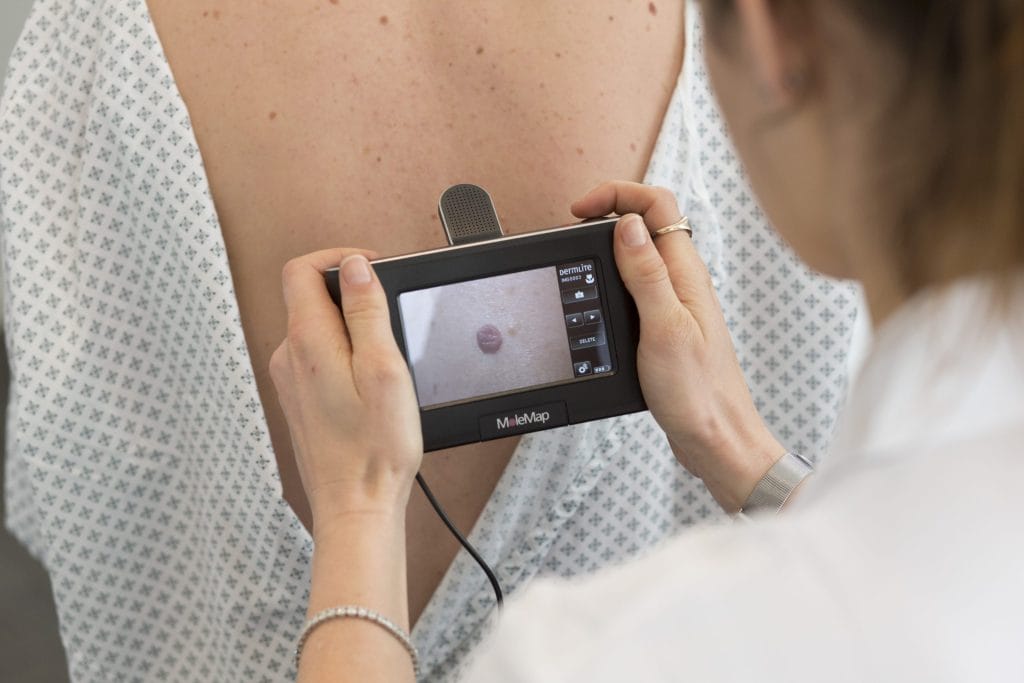Regular skin monitoring is essential, especially when it comes to identifying and tracking any changes in moles and other skin lesions. For individuals in Essendon who rely on mole mapping services, understanding how to stay on top of these changes between appointments is crucial for effective skin cancer prevention.
Mole mapping offers a structured and precise method for documenting skin changes, but self-monitoring in the months between sessions is equally important. Here are some practical tips on how you can keep an eye on your skin between visits for your mole map in Essendon.
Importance of Self-Monitoring Between Mole Mapping Sessions
Mole mapping provides a comprehensive overview of your skin, capturing high-quality images of every mole and lesion. At Dermascan, we use advanced Fotofinder technology to ensure detailed and accurate documentation. However, changes in moles and skin texture can occur at any time, and being vigilant between appointments ensures early detection of potentially harmful lesions.
By conducting regular self-examinations, you’ll complement the professional mole mapping in Essendon residents rely on, ensuring nothing goes unnoticed.
The ABCDE Rule for Self-Examination
The ABCDE rule is a widely recognised method for identifying suspicious moles. Between your professional mole mapping appointments, keeping these characteristics in mind can help flag potential issues early:
- A for Asymmetry: If one half of the mole doesn’t match the other, it could be a concern.
- B for Border: Irregular, ragged, or blurred borders may signal a problem.
- C for Colour: Uneven shades or multiple colours in a single mole should be monitored.
- D for Diameter: Moles larger than 6mm in diameter could be at higher risk.
- E for Evolving: Any changes in size, shape, colour, or texture are worth noting.
While this method is not a replacement for professional mole mapping in Essendon, it is an effective tool for keeping track of changes at home.
Documenting Skin Changes
Creating a habit of documenting changes is an excellent way to keep track of your skin’s condition. You can use a phone or digital camera to capture clear, high-resolution images of moles or skin areas of concern. Label each image with the date and the location of the mole, then compare these images over time.
This will allow you to notice even subtle changes between your mole mapping sessions in Essendon.
Incorporating these personal records with the automated total body mapping at Dermascan can offer a well-rounded approach to early detection.
The Role of Technology in Skin Monitoring
Apps and tools are now available to assist with tracking skin changes, which can be helpful in combination with professional mole mapping. These tools allow you to log and photograph moles, setting reminders for self-checks or your next mole mapping appointment. However, it’s important to remember that these tools are supplements, not replacements, for expert assessments like those provided at Dermascan.
Skin Care and Sun Protection Between Sessions
Between mole mapping appointments, protecting your skin from harmful UV rays is vital. Regular application of high-SPF sunscreen can reduce the risk of skin cancer significantly. In Australia, where UV levels are high year-round, wearing protective clothing, hats, and sunglasses should be a daily habit. These measures help prevent new moles from forming and protect existing moles from changing.
Identifying Red Flags Early
There are specific warning signs that should prompt immediate action, even if your next mole mapping session is months away. These include:
- A new mole or lesion that appears suddenly
- An existing mole that starts to itch, bleed, or become tender
- Any mole that changes rapidly in appearanceIf you notice any of these changes, don’t wait for your next mole mapping Essendon appointment. Contact your healthcare provider or Dermascan for a thorough check-up.
The Emotional Aspect of Monitoring Skin Changes
Staying vigilant about your skin’s health can sometimes feel overwhelming, particularly if you have a history of skin cancer or a large number of moles. Knowing that professional support is available through mole map in Essendon can offer peace of mind. At Dermascan, we understand the concerns many people face, and our team is here to support you at every stage of your skin health journey.
Why Choose Dermascan for Mole Mapping in Essendon?
At Dermascan, we use state-of-the-art Fotofinder technology for mole mapping Essendon residents can trust. Our AI-powered system provides high accuracy and helps in tracking changes over time. Whether you need an annual skin check or more frequent monitoring, we are dedicated to providing thorough, professional care in a comfortable setting. By choosing Dermascan, you’re opting for precision and expert knowledge in safeguarding your skin’s health. At Dermascan, our team of highly trained Melanographers are lead by Mr Stephen Salerno who is a Plastic and Reconstructive Surgeon who specialises in the diagnosis and treatment of skin cancer and in particular Melanoma. He has over 16 years experience and regularly attends the Melanoma clinic at the Alfred Hospital.
Monitoring your skin between mole mapping sessions in Essendon is a vital step in early detection of potential skin cancer. Regular self-checks, documenting changes, and prioritising sun protection are all essential practices. And when it comes time for your professional check-up, the mole mapping Essendon specialists at Dermascan will be there to provide the detailed, expert care you need.
Book Your Next Mole Map Appointment
Protect your skin today by scheduling your next mole mapping appointment with Dermascan. Book an appointment and learn more about how we can assist in monitoring and safeguarding your skin’s health.

